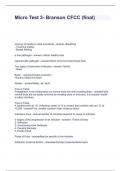WGU C963 Study Guide (Version 4)
By ExamNavigator
, WGU C963 Study Guide (Version 4)
1. What was the Enlightenment
Answer: Ideas centered around the value of human happiness.
A period in Western European history following the Middle Ages. The source of our ideas
about natural rights.
2. Who was John Locke?
Answer: an English philosopher, lived in the 17th century, ideaswould be used as the basis for
American Revolution, known as the "Father of liberalphilosophy"
3. Why did John Locke think the state of nature confirms natural rights?
Answer: He believed that most people are good and respect the rights of others because of their
conscience tells them they should.
4. What natural rights did Locke believe the social contract should protect?
Answer: -Life, liberty, property
5. What is the meaning of the term popular sovereignty?
Answer: Government based onconsent of the people, people decide for themselves whether
their territories wouldenter the Union as free or slave states.
6. What is the meaning of the term consensual political rule?
Answer: There is an ongoing renegotiation about social contracts because it doesn't always
fulfill our natural rights. If our rights aren't fulfilled, it could cause social and political
conflict.
7. How were the Declaration of Independence, the Constitution, and the
Bill of Rights influenced by Enlightenment thinkers?
Answer: Declaration of Independence-each citizen has the right to reason, autonomy, and the
notion that all humanbeings are equal by nature.
Constitution-Liberty, equality, and justice helped to create the conditions for theAmerican
Revolution.
Bill of Rights-recognized that people had basic rights that the government mustprotect, such
as freedom of religion, speech, and the press.
8. Describe the structure of the government under the Articles of Confederation.
Answer: Unicameral (one-house) legislature, not national executive or judiciary, delegates to
Congress were appointed by the state legislatures, and each state hadone vote.
9. Name the powers of the government under the Articles
Answer: The power to declarewar, appoint military officers, sign treaties, make alliances,
appoint foreign ambassadors, and manage relations with Indians.
,10. One of the weaknesses of the Articles of Confederation was the unanimousconsent of the
states required to amend (change) the Articles of Confederation. What are the other
weaknesses?
Answer: Each state only had one vote in Congress,no matter the size. Congress had no power to
tax. Congress did not have the powerto regulate foreign trade. There was no executive branch to
enforce any acts passedby Congress,
11. Why was Shays Rebellion an example of these weaknesses?
Answer: Exposing thatthe government could not form a military or draft because the federal
government did not have money due to the fact that they did not have the ability to enforce
taxesupon the citizens.
12. What were the VA and NJ plans?
Answer: Virginia Plan - Called for three branches ofgovernment and two houses of Congress.
Representation in each house would bedetermined by population.
New Jersey Plan - called for three branches of government and a single house ofCongress.
Proposed equal representation for each state in Congress.
13. What was the Great Compromise (also known as the Connecticut Compromise)?
Answer: A compromise made between the Virginia and New Jersey plans, it was meant to
address the issue that states with a larger population wanted congressional representation
based on population, while smaller states demanded equal representation. (Constitutional
convention)
14. In one sentence for each, describe the three other compromises made at the Constitutional
Convention.
Answer: 3/5th Compromise - 3/5th of the slave populationwould be counted for determining
direct taxation and representation in the House ofRepresentatives.
Separation of Powers + Checks and Balances - Three branches of government (executive,
legislative, and judicial) are kept separate, each branch is given certainpowers to check and
balance the other branches.
Federalism - A system of government in which entities such as states or provincesshare power
with a national government.
15. Who were the Federalist and the Anti-Federalists?What did the Federalists believe?
What did the Anti-Federalists believe?
Answer:
Federalists - A centralized national government with strong fiscal roots, felt that the
Constitution was open for interpretation.
Anti-Federalists - Believed the Constitution created a central government that was too strong
and that would abuse power.
, 16. What was the general purpose of writing the Federalist Papers?
Answer: The Federalist Papers was a series of essays written by Alexander Hamilton, James
Madison,John Jay.The purpose of the Federalist Papers was to convince the American peopleto
support ratification of the Constitution.
17. What was the main argument expressed in Federalist Paper #10?
Answer: Warningthe power of factions and competing interest over the United States
Government.
18. What was the main argument expressed in Federalist Paper #51?
Answer: Proposesa government broken into three branches.
1. Executive
2. Legislative
3. Judicial
19. The last four states to ratify the Constitution were Virginia, New York, NorthCarolina and
?
Answer: Georgia
20. What is the difference between the idea of separation of power and the ideaof checks and
balances?
Answer: Separation of powers - divide responsibility
Checks and Balances - making sure branches balance each other
21. What does the executive branch of government do?
Answer: Sign laws, veto laws,pardons ppl, appoints judges, elected every 4 years.
22. What does the legislative branch of government do?
Answer: Make laws, approve presidential appointments, 2 senators from each state, #of
congressman based onpopulation.
23. What does the judicial branch of government do?
Answer: Decide if laws are constitutional, appointed by president, 9 judges, can overturn
rulings by other judges.
24. How are the workings of the US government today (federal system) different from the
way government worked as a confederal system under the Articles of Confederation?
Answer: In a confederation, the state or local government issupreme. The national government
only wields powers granted by the states. In afederal system, power is shared by the national
and state governments.
25. What are the powers of the legislative branch of the federal government?-
Answer: Makes all laws, declares war, regulates interstate and foreign commerce andcontrols
taxing and spending policies.





